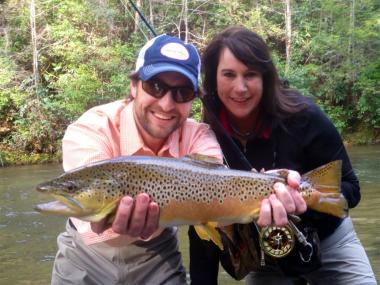
Fish caught in the North Georgia mountains. Photo by Lindsey Brown, @lindstakesphotos
Where to Go Fishing in Georgia
Wet a line on Georgia's lakes, streams and coast.
The variety of waters across Georgia means a dizzying assortment of game fish, from brightly hued rainbow trout in North Georgia’s mountain streams, to giant grouper off the coast of Jekyll Island, to feisty hand-size bluegill just about anywhere. Here is a quick look at Georgia fishing: where to go and what fish you’ll find when you get there.

Big fish can be found in Lake Allatoona and Lake Lanier, both managed by the U.S. Army Corps of Engineers. There, you’ll find striped bass ranging from five to 25 pounds, largemouth bass, crappie and spotted bass. Lanier is stocked with walleye, and Allatoona is known for its spotted bass and hybrid bass. Many fishing guides offer affordable half-day trips on Allatoona and Lanier, which would allow the whole family to enjoy time on the water.
Clarks Hill Lake is home to stripers and hybrid bass. As the state’s largest reservoir, Clarks Hill has more than 1,200 miles of shoreline, some of which is accessible at two Georgia state parks: Elijah Clark State Park and Mistletoe State Park.
Other lakes are well-known haunts for largemouth bass, the most popular game fish. Lake Seminole, a 37,500-acre reservoir at the southwest corner of the state, grows some big ones, and Lake Walter F. George (also known as Lake Eufaula) is frequently the site of professional bass-fishing tournaments. West Point Lake, a 25,900-acre reservoir operated by the U.S. Corps of Engineers on the Chattahoochee River on the Georgia-Alabama border, consistently offers top-notch largemouth bass fishing.
Many of Georgia’s state parks have lakes that can be fished. Lake Tralyta at Vogel State Park near Blairsville is a 22-acre reservoir with bass, bluegill and the occasional trout. Victoria Bryant State Park near Royston has a pair of ponds stocked with bass, bream and catfish. Reed Bingham State Park near Adel has a 375-acre lake with bass, crappie and catfish.

The Georgia Department of Natural Resources maintains more than three dozen artificial reefs that provide food and shelter to an array of fish: black sea bass, cobia, bluefish, red snapper, amberjack and grouper. Spotted sea trout and red drum swim the many creeks and rivers that flow into the sea. Where you find sea trout and red drum, you’re likely to find flounder. Although heading offshore requires a boat, docks and piers are good places to fish for sheepshead and black drum.
One of the best ways to experience saltwater fishing in Georgia is to connect with an outfitter, who can provide you with all the gear needed and take you to the most promising locations. Common places to find these include Brunswick, St. Simons Island and Savannah.
The marshlands are great spots to gather clams and oysters. There are specially designated recreational shellfish harvest areas in Camden, Chatham, Glynn, Liberty and McIntosh counties.

While most of Georgia’s trout streams are concentrated in the mountains of North Georgia, where clean, cold water is just part of the landscape, one of the most popular trout-fishing spots can be seen from I-285 in north metro Atlanta. Water flowing from the bottom of Buford Dam is cold enough and clean enough to make the Chattahoochee River prime trout habitat in the middle of Atlanta.
Trout season is open from the last Saturday in March through Oct. 31. Trout fishing requires an additional license to the regular fishing license required of all anglers ages 16 to 64.
Experienced trout anglers will want to take trips to two specially managed creeks: Dukes Creek near Helen and Waters Creek in the Chestatee Wildlife Management Area north of Dahlonega. Dukes Creek and its tributaries are open to fishing year-round by reservation only. Waters Creek is open just three days a week only during trout season.
Many Georgia State Parks, including Black Rock Mountain, Unicoi, Vogel and Don Carter are excellent places for beginning anglers. All of these participate in the Fishing Tackle Loaner Program, which lets visitors try out a day of fishing before buying their own equipment.

Georgia’s 11 Public Fishing Areas are designed and operated to make a day of fishing a successful one. The lakes and ponds are fertilized to make them more productive, and they have fish attractors where fish like to hang out. They all have boat ramps, restrooms and picnic tables. No matter where you go fishing in Georgia, no matter what bait you use, you’re sure to land a good time.


